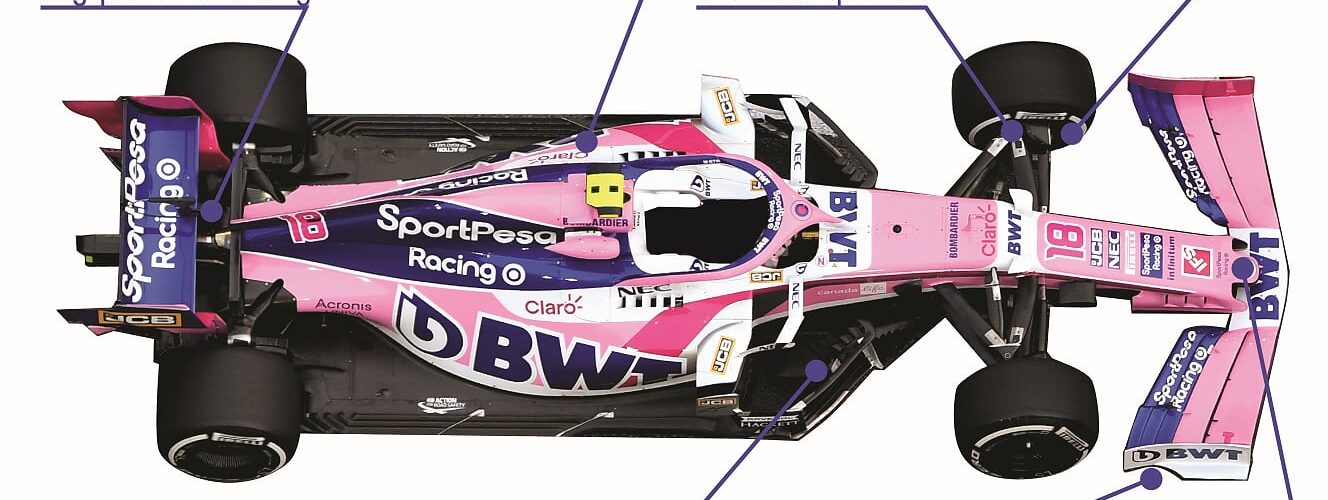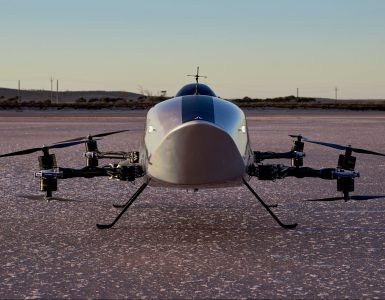Racing Point have come a long way in the past year. The Silverstone-based squad changed from Force India to SportPesa Racing Point mid last season with the Stroll family lead investment. Despite the timing of this change, it was too late for the team to ramp up development of the launch specification of the RP19 car. However, rather than this late start stymying the team, their mid-season development has brought it right back into contention for the midfield.
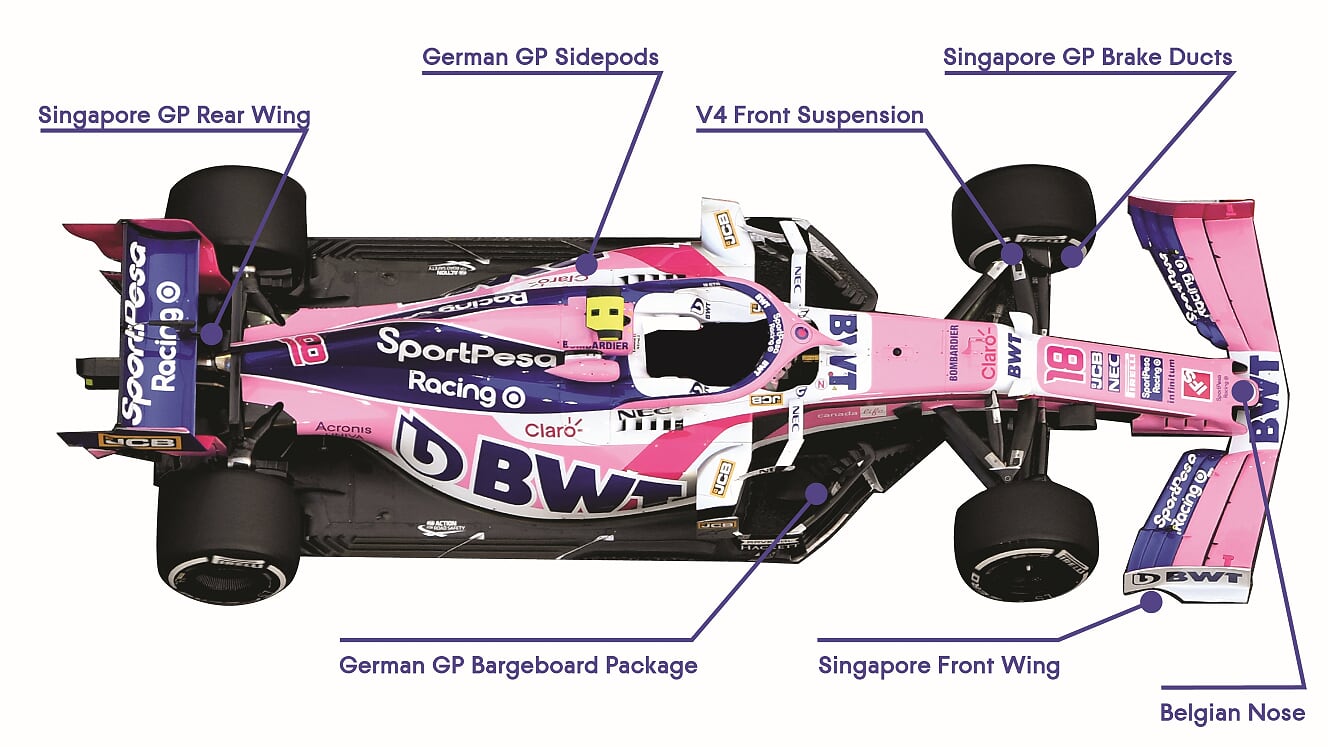
After an early season update, the car has massively benefitted from a continuing series of updates – even up to Singapore, the car was gaining major new parts. With these upgrades, the car has followed all of the key design trends of 2019, reacting to the new aero rules introduced for this year. Very little of the car has been left unchanged, and some parts have even been updated several times.
Nose
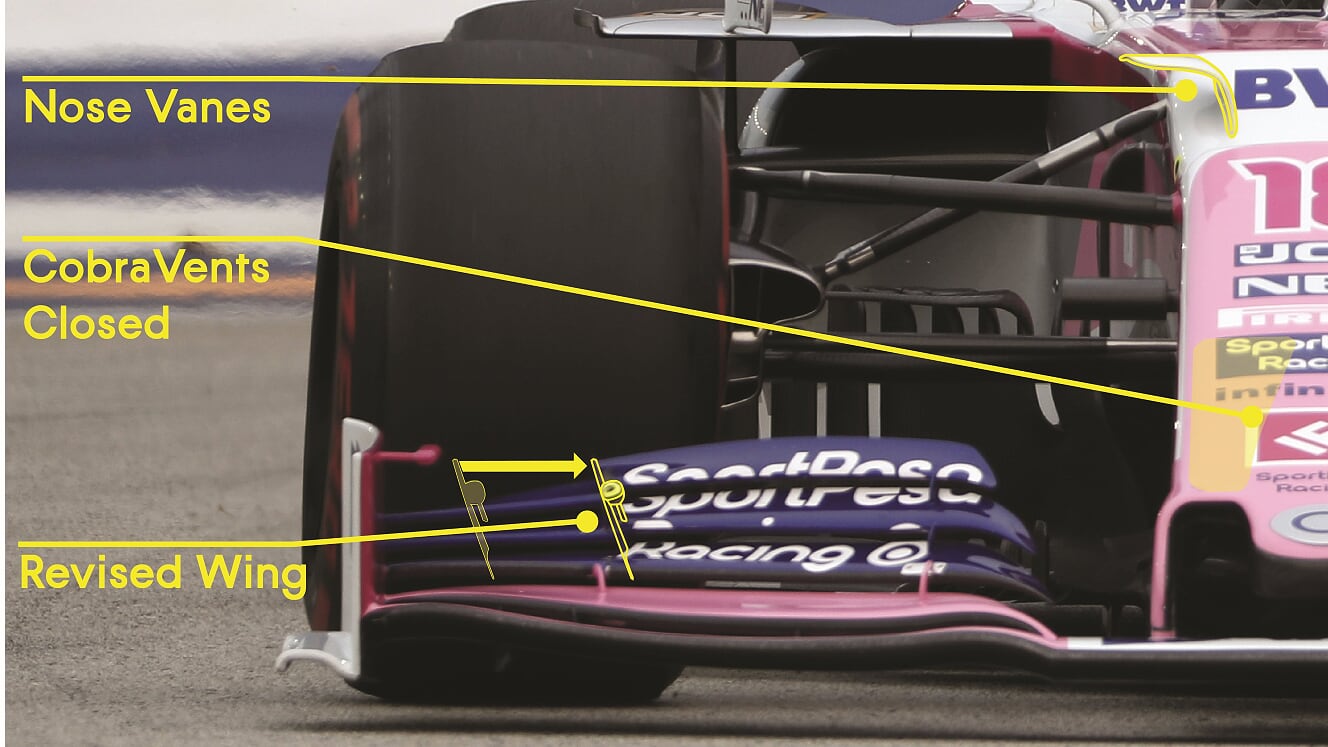
The car’s nose shape harks back to mid-2015, when the team changed the design to incorporate nostril-like openings, which they termed the ‘vented cobra’ design. Designed to overcome the blockage created by the nose over the front wing, such openings have been copied in various ways by other teams. By allowing more airflow through the nose, the airflow along the underside of the nose is improved, providing a better airflow to the turning vanes and reducing the risk of the air separating from its surface.
These openings were exploited mid-season, with the additional of a wide aerodynamic flap hanging below the nose, similar to the ‘cape’ raced by Mercedes since 2017. This idea has been copied by most other teams through the season, as it exploits an otherwise underworked area of the car for aerodynamic gain. Creating high pressure above and low pressure below, the cape may produce some downforce of its own, but the primary gains are the vortices spiralling of each side of the cape’s trailing edges. These vortices feed into the bargeboard package and spin in the opposite direction to the front wing’s Y250 airflow, adding extra energy to these areas for a better outwash effect.
No sooner was the caped nose introduced, than it was replaced with a completely different concept for Spa-Francorchamps. The Spa nose closed the vents and lost the cape, instead the front wing mounting pylons became shapelier with a series of Ferrari-like slots. In this set up, it’s the front wing mounting pylons that are doing the work, rather than the vents and the cape.
Front wing
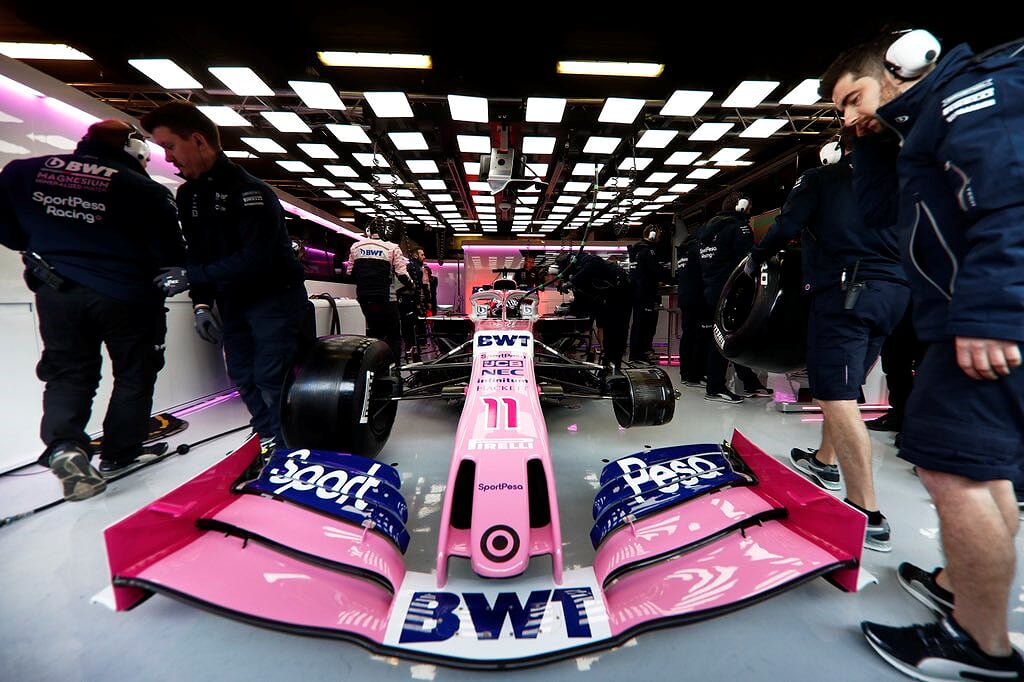
Allied to the nose changes, the front wing gained an upgrade in Singapore. This wasn’t a wholly new wing, as only the three flap sections and the endplate were revised. The three blue-painted flaps are made up of a large adjustable span and a narrower fixed outer section. The front wing’s downforce level is changed by altering the angle of attack of the inner adjustable section. In Singapore the split between adjustable and fixed sections was altered to have a wider fixed area. This may mean that the same degree of adjustment provides a smaller change on downforce effect, but it’s more likely that the reason for the change was to move the join between fixed and adjustable, as this area has more freedom to be exploited within the rules. The outswept shape of the vertical join in the wing helps create the outwash lost with the new aero rules for 2019. Teams use the vertical plates in the joint as turning vanes, so moving their position relative to the front wheel will alter their outwash effect.
To the side of this area, the front wing endplate sees its third major iteration, with the horizontal footplate section at the bottom of the endplate being the crucial area. This arched section was initially truncated shorter than the full length of the endplate. Then, mid-season, it was truncated with diagonal slash-cut, while in Singapore it was further truncated with a more extreme cut. Having been a feature of front wings for over ten years, the arched footplate serves two basic purposes; first, to help prevent air being sucked into the low pressure are below the wing, thus costing downforce. Secondly, it does this by rolling up a vortex between the arched section and track. This vortex is then used to push airflow around the front tyre offsetting the wake the spinning tyre creates. By shortening, then cutting the exit of the arched footplate, the vortex can be manipulated and being further from the tyre tuned to interact even better with the tyre wake.
Sidepods
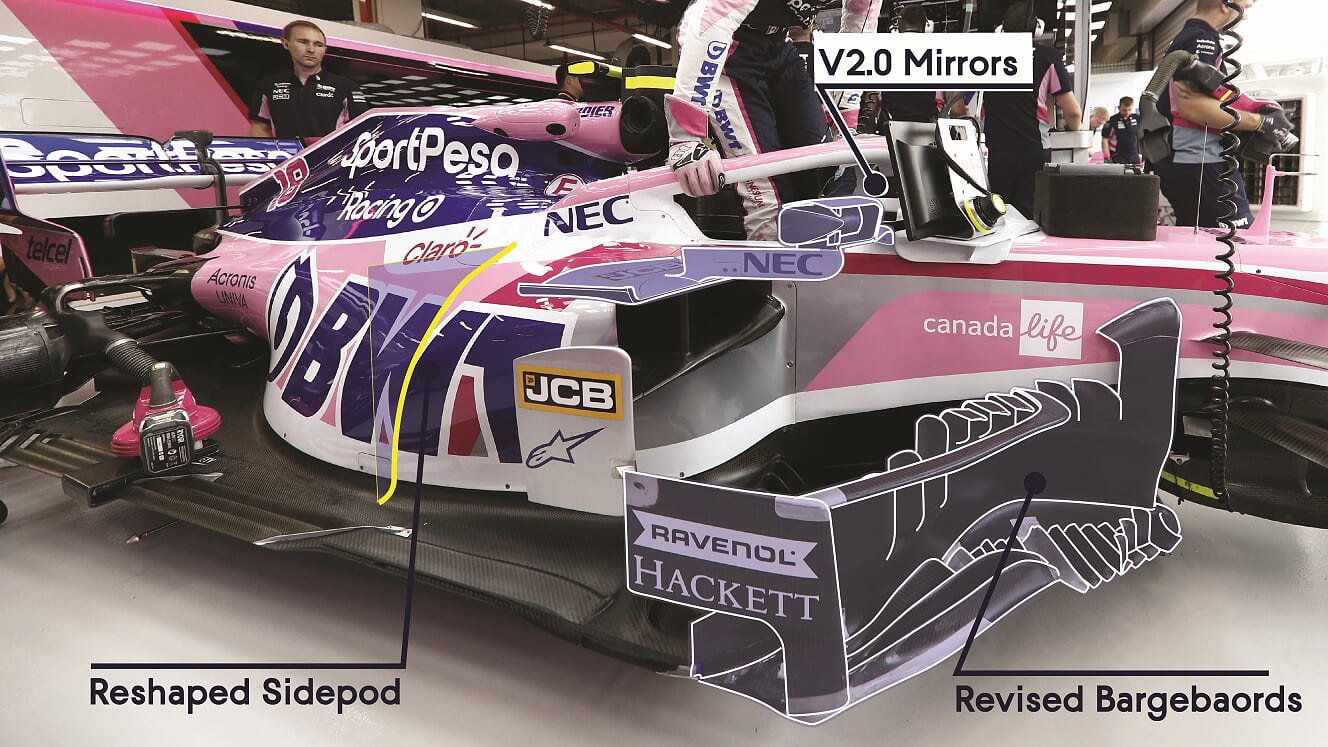
Part of the update to the RP19 from the outgoing 2018 car was to introduce high topped sidepods, by repositioning the side-impact crash structures within. This allowed a higher sidepod inlet and larger undercut beneath to direct airflow around the sidepod towards the top of the diffuser for more downforce. Thus, the launch spec of the car has heavily undercut sidepods, the undercut leading all the way back along the sidepod shape. This same sort of design is widely exploited by other teams up and down the paddock.
While bargeboard development is not a never-ending series of small updates, the RP19 did gain a major change in Germany with a boomerang wing added above the bargeboard package, revised sidepod fins and floor edge treatment.
This update also saw the introduction of two ears added to the joint between the nose and chassis. These little flow conditioners sit in a blind spot in the aero rules, the slope to the front of the monocoque just as it meets the nosecone forms a wedge-shaped space that can still have bodywork fitted into it. Thus, these ears neatly fill the edges of this space. They push airflow outwards and downwards, helping the general direction of the airflow over the front of the car.
But this series of changes at the front were merely part of far larger shift in sidepod design philosophy as the car now features heavily revised sidepods, especially in the area around the radiators and the coke bottle shape tapering towards the rear. Gone is the long undercut channel along the sides, instead a jelly mould shape forms the mid-section of the sidepod, widest at the floor level and curving around to meet the centre of the car, without any undercut. Such a design has been exploited by the Red Bull teams this year and also adopted by McLaren mid-season. This solution takes advantage of the high sidepod inlet and this year’s more powerful bargeboards. Fundamentally, the concept seeks to make use of the clean airflow passing over the sidepod top, to route it down and around the sloped sidepod top, focussing it on the diffuser to make more downforce. The lower airflow that used to pass through the sidepods undercut is still there, but now routes around wider, guided outwards by the bargeboards and back inboard by the coke bottle shape. During pre-season testing, teams running with the bright green flow viz aero test paint showed the obvious path of the flow of air over and under the sidepod.
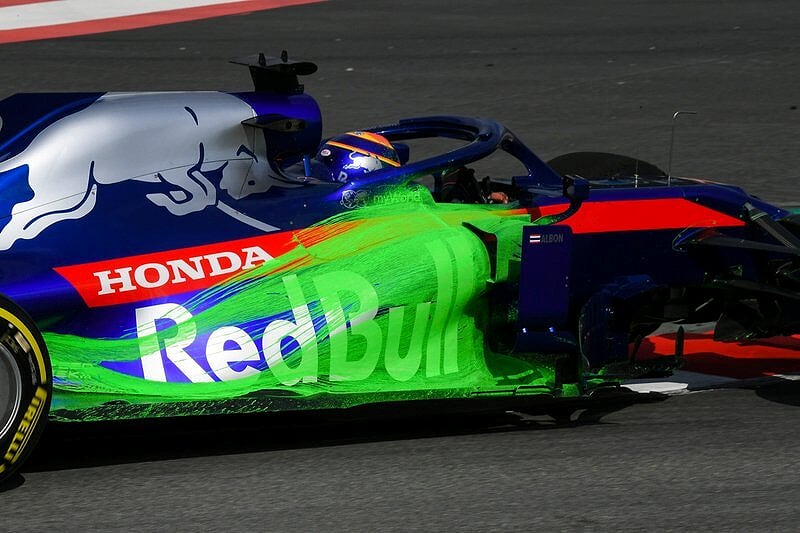
To accommodate the reshaped bodywork, the radiators within the sidepod are also reshaped. Before, they were wider at the top and narrow at the bottom to suit the undercut bodywork shape, now they are the reverse – wider at the bottom to sit inside the wide based shape.
Suspension
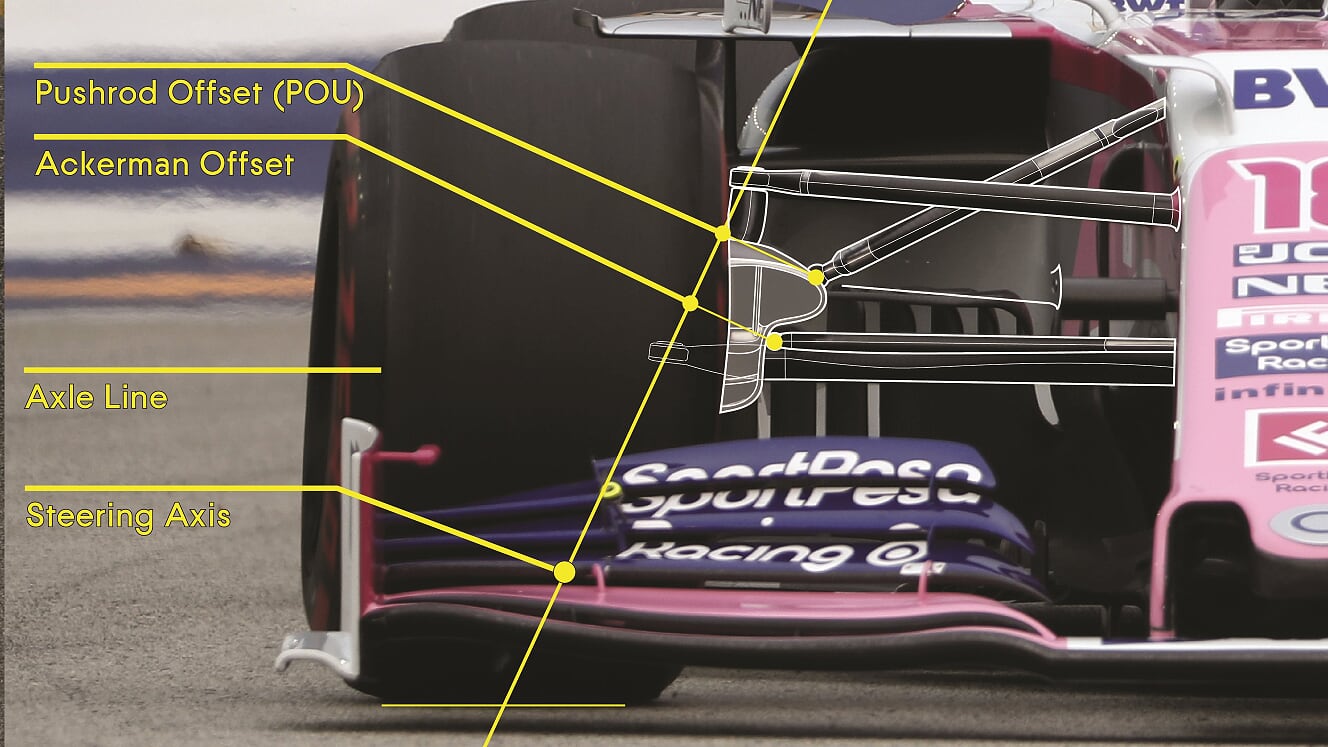
As with the side impact crash structures attached to the monocoque, the front suspension was also a revision from 2018 to 2019. For the RP19’s launch spec, the car switched to the higher mounted front wishbones. This design raises the inner mounting point of the wishbones on the chassis to be as high as possible, leaving more space for the front wing’s wake to pass underneath. At the front wheels, the front upright now extended out of the front brake duct bodywork to protrude upwards to meet the top wishbone, the lower wishbone meets the upright at around the front axle height.
Since this V1.0 suspension was introduced, there have been three key updates. The first was the change to the front upright mounting, which switched from the top wishbone’s outer pivot passing inside a slot in the upright, to a cleaner design where the pivot is below wishbone.
Then, the third change was a key update to alter the pushrod geometry. Even with the first iteration, the pushrod that translates the wheel forces up to the front springs and dampers, was mounted to the upright and offset from its steering axis. This way, as the front wheel turned, the pushrod was displaced due to its offset from the steering axis. This means that the effective length of the pushrod changes with steering and thus ride height is also altered. In corners, the front ride height can drop to keep the front wing close to the ground for maximum efficiency. This geometry, known as Push on Upright (POU) has been exploited for many years, by all teams, but last year teams started to push the FIA rules on how much ride height could be gained from a set steering angle.
By increasing the offset of the pushrod mount to the steering axis, a greater ride height change could be gained, further aiding front wing performance through corners. This more extreme set up can be seen as the pushrod mount of the upright now extends through the front brake bodywork, through the year this has been adopted up and down the grid.
The fourth key change was related to the POU geometry, but this affected the steering track rod. It was evident not long after the POU change that the track rod mounting to the upright was also changed. This placed the track rod pivot further inboard, away from the wheel and its steering axis. Geometry changes like this have an effect known as Ackerman steering.
Ackerman is the effect of how much the inner and outer wheels steer through a corner. You would expect the outer wheel to turn less, as it moves in a wider arc than the inner wheel for a given corner radius, and this is known as full Ackerman. From observation, F1 cars typically run what’s known as parallel steering. That is that the wheels both turn the same amount for a given steering input, thus one of the wheels isn’t turning in line with the ideal corner radius, i.e. the outer wheel turns too much or the inner wheel turns too little. While this may seem an odd geometry, I’m told that the effect at the wheel of an F1 car, loaded heavily by the tyre’s grip and downforce, is negligible.
Moving the outer track rod pivot inboard would have the opposite effect, known as reverse Ackerman. The outer wheel turns more than the inner wheel – again the mechanical effect at the contact patch isn’t an issue, but the ride height effect of the POU is. With more steering angle, the outer wheel will displace the pushrod more and reduce the front ride height even further. So, it’s possible that the reverse Ackerman steering set up is more to do with aero than steering effect.
This track rod position change has also been adopted by Mercedes and Williams with their extreme POU set up. Racing Point, like Mercedes made use of this change to alter that front brake duct design, creating an inlet behind the track rod pivot to encourage more airflow through the wheel. For Racing Point, this brake duct update came in Singapore.
Rear end
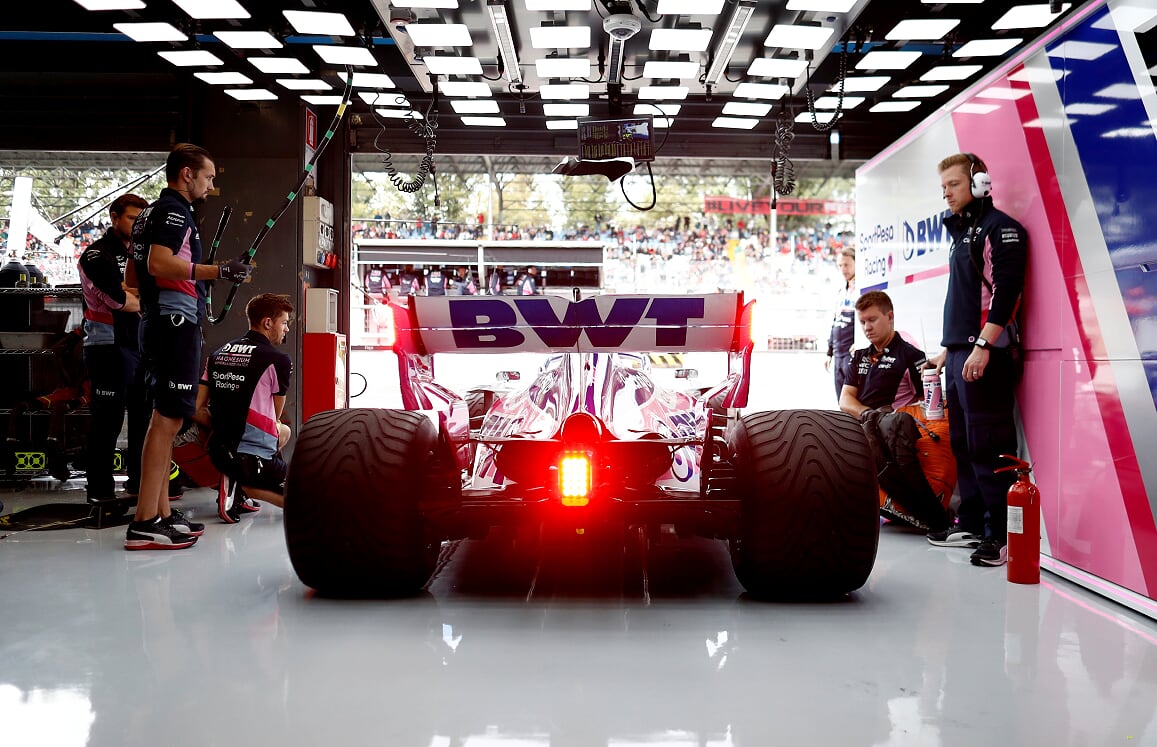
It has been harder to pick out the changes at the rear of the car, especially in the dark recess of the cars underfloor and diffuser. One area of constant variation to suit each circuit has been the T-wing. This sits on the tail of the engine cover and provides some added downforce, which can be varied by its design. Usually, the car’s set up sees a double decker wing run. For the high downforce demands of Hungary, this was multiplied to four elements, with two wing profiles stacked on top of each other, whereas at Monza to cut drag the set up was reduced to a single element. Likewise, rear wing development sees different shaped wings introduced to suit the track, Singapore gaining an entirely new wing profile with the slightly raised centre to the leading edge.
Conclusion
After a series of updates spanning some six to seven races, the RP19 is as cutting edge as the rest of the grid. Even with major aero rule changes, such as were introduced to the front wing this year, teams soon converge on similar ideas. As the season now plays out at the final flyaway races, there is little left missing from the car and Racing Point will be ready to bring the fight to McLaren and Renault.
While such huge progress mid-season this year bodes well for 2020, where there will be more certainty in the team’s resources and less rule changes to accommodate.

